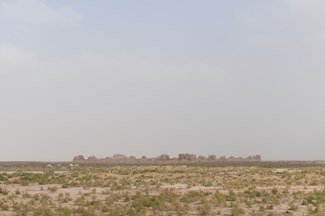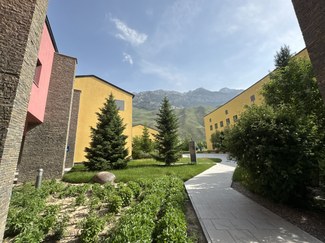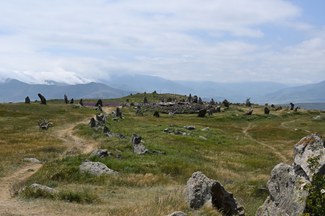Report from our 2025 Judith A. Lerner, Ph.D. Summer Traveler: Vikentiy Parshuto
ISAW is pleased to share the summer travel report from the 2025 Judith A. Lerner, Ph.D. Summer Travel Fund recipient, Vikentiy Parshuto.
Observations from Central Asia and the Caucasus: Notes from the Field (Spring–Summer 2025)
Travelling through parts of Central Asia and the Caucasus over the past several months provided the opportunity to encounter archaeological sites and local communities that until now had remained somewhat peripheral to my work. Adjustments to the itinerary were necessary due to administrative permissions and wider geopolitical disruptions, but the comparative perspective gained was useful for ongoing research.
Khorezm: Kyrk-Kyz, Nukus: Sites and Museums.
 Kyrk-Kyz
The first stage was spent entirely at Kyrk-Kyz in Khorezm. The site’s stratigraphy is notably complex, spanning periods from Ancient Khorezmian (4th–2nd centuries BC) to Afrigid (7th–8th centuries AD). The most prominent fortress is usually dated to the 1st century AD. The area is extensive, covered in ceramics and surface habitation traces. I was present for the final stages of excavation documentation, working with S. Bolelov, whose approach to drawing sections was distinct—a practical method rooted in field traditions from previous decades. The equipment itself, largely unchanged since the 1970s, serves as a reminder of continuity in local archaeological practice.
Kyrk-Kyz
The first stage was spent entirely at Kyrk-Kyz in Khorezm. The site’s stratigraphy is notably complex, spanning periods from Ancient Khorezmian (4th–2nd centuries BC) to Afrigid (7th–8th centuries AD). The most prominent fortress is usually dated to the 1st century AD. The area is extensive, covered in ceramics and surface habitation traces. I was present for the final stages of excavation documentation, working with S. Bolelov, whose approach to drawing sections was distinct—a practical method rooted in field traditions from previous decades. The equipment itself, largely unchanged since the 1970s, serves as a reminder of continuity in local archaeological practice.
In Nukus, time was spent in the Institute of Archaeology, looking at conservation work and collections mostly unattended except for ongoing cataloguing. There were some discussions about ceramic documentation, which will inform a future talk in Siena. Visits to museums in the city were limited due to opening hours, but the Savitskiy collection and National History Museum offered some interesting examples of regional material.
Bukhara
In Bukhara, brief participation in the Uzbek-American Expedition coincided with the conclusion of fieldwork. The excavation at trench 15, marked by seven layers of fortifications, stood out. My role was typical – documentation and general excavation tasks, with little unusual to report in terms of method or findings.
Panjikent, Ferghana: Between Sites
A short stop in Panjikent allowed for some fieldwork discussions—mainly planning for a prospective trench location. This area got the name of Area 31 further, and was excavated by the Tajik team during June and July, it was documented by the team of Panjikent Expedition from the Hermitage. The visit to Kokand started the trip around Ferghana. The Khaydar-khan Palace is representative of the old habit in the Area of Ex-Soviet Union to turn palaces into museums. The atmosphere in Kokand’s old quarters reflects continuity in urban life, with an evident focus on family and children (Ferghna is probably the most populous province of Uzbekistan). Some late Soviet brutalist architecture is present near the Friday Mosque, contrasting with older religious structures. The Museum of Great Scholars features portraits and short biographical notes of figures from Musa al-Khorazmy to modern Uzbek academicians. In Andizhan, the National History Museum’s archaeological display, particularly Chust culture ceramics, was noteworthy; otherwise, the city’s character seemed much the same as other provincial centres.
Osh and Sulaiman-Too: Museums and Public Space
Entering Osh after crossing the border from Andizhan, the town’s centre becomes far more pleasant than the outskirts. Sulaiman-Too mound dominates the city’s layout, doubling as a reserve and a focal point for two museums – one at the base and one inside the mountain itself. The lower museum organises sites by period and uses QR codes for artefact documentation; its exhibition design is thoughtful, far above average for the region. The upper museum, in the cave, focuses on spiritual and burial practices, combining natural space and artefactual display more effectively than most comparable venues. The public spaces and sculpture are similarly planned and create a vivid atmosphere in the city.
Naryn and Bishkek: Everyday Encounters
 The campus of Central Asian University in Naryn
The campus of Central Asian University in Naryn
In Naryn, the University of Central Asia has become a defining feature of the town, giving it a younger feel. A brief hike in the Salkyn-Tör park provided familiar scenes – herders and mixed livestock in the uplands. Bishkek displays a coordinated approach to public sculpture and park design, with works by T. Sadykov particularly prominent. Museums here – the State History, geology, and fine arts – were visited, and the History Museum’s approach to archaeology and ethnogenesis deserves mention for its clarity, though the narratives are inevitably shaped by the state. Issyk-Kul was omitted this time due to a medical obstacle.
Almaty: Shifts in Landscape and History
Crossing into Almaty, differences between Kazakhstan and Kyrgyzstan were immediately visible, especially the transition to open steppe. Russian commercial presence remains pronounced. Monuments, including the Golden Man, are organised chronologically along the Independence Monument, presenting a distillation of national history from Tomiris and Cyrus to Soviet and independence-era scenes, all with recognisable historical figures and events. Museum displays broadly resemble those in Bishkek, albeit slightly older.
Armenia: Churches, Monasteries, and Everyday Ruins
The Armenian segment was more improvised. Sites varied from a new Yezidi temple near Yerevan to one of Armenia’s oldest churches, Yererouk, built in a Syriac style atypical for the region. Gyumri, constructed mostly of black tuff, is noted for ethnographic museums, colonial architecture, and Soviet sculpture—an interesting variation within the Soviet canon.
Northern monasteries—Akhtala, Haghpat, Senahin—are associated with the poet Sayat-Nova, whose biography crosses several cultures. The town of Spitak, devastated by the 1988 earthquake, has a metal-sheet church built after the catastrophe to honour the dead. Now it is at the centre of town’s cemetery, the graves of which mostly have one and the same second date: 1988.
 The site of Zorats Karer in Armenia
The site of Zorats Karer in Armenia
Further sites included the monastery of Sevanavank (overrun with tourists), Khor Virap (noted for its view on Mount Ararat), Areni cave (archaeological finds related to early wine production), and Noravank, which is central for work on khachkar traditions. Jermuk, a resort town with Soviet-era ambitions, was visited but is mostly remembered for its unrealised projects and the alley of Heroes (Stone Heads).
In the south, Tatev monastery stands out for its former prominence. Zorats Karer megalithic field, Orbelyan Karavanserai (a Silk Road waystation with distinct architecture already on the way to Sevan), and an Urartian inscription at Tsovinar on the shore of Sevan, offered useful material for comparative purposes. Last, Echmiadzin—the centre of Armenian church life—was seen briefly at the end of the trip.
Yerevan: Museums and Colleagues
Museum visits in Yerevan were completed with some analogy work to prior findings; the Opera was attended, and one short lecture was given at the Centre of Living History. Notably, access to unpublished Urartian bronzes was made possible through Dr. Annarita Bonfanti, who coincidentally has been working on them at the time, providing some hands-on documentation experience.
Overall, the trip afforded a set of primary local observations, occasional comparisons for archaeological research, and meetings with colleagues otherwise difficult to see. The landscape, museums, and local practices together provided material to consider for further work.
 The steppes on the way from Bishkek to Almaty
The steppes on the way from Bishkek to Almaty
 The monastery of Tatev in Armenia
The monastery of Tatev in Armenia
 The fragments of Urartian bronzes from the storages of the History Museum of Armenia
The fragments of Urartian bronzes from the storages of the History Museum of Armenia